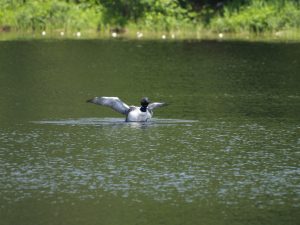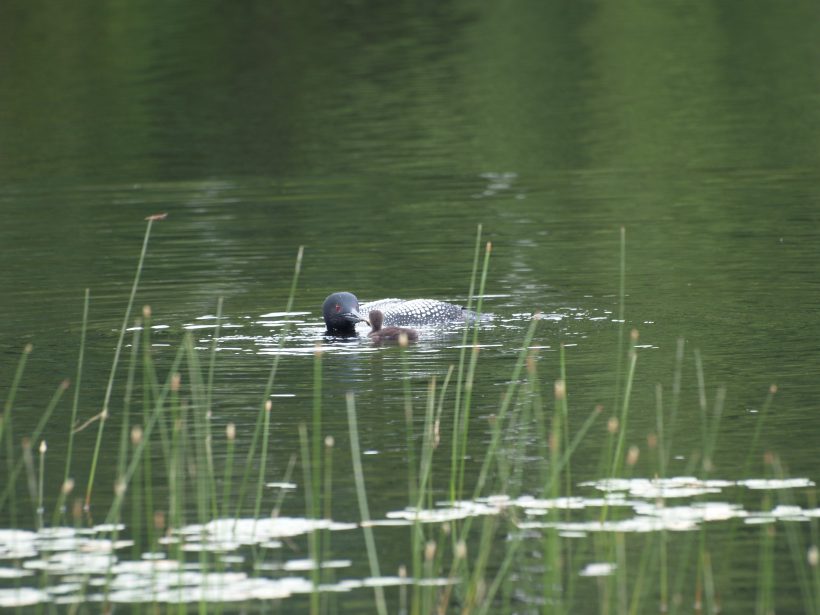
Couple of issues back I entitled a column Geese and Loons, and then I found out I had a lot to say about geese, and never did get around to saying anything about loons.
It is nice to see any of the birds back in the spring, even the crows. For some reason or other more mention is made of the Robin than any other bird, perhaps because it is so common, and one bird that everyone knows. To people who spend a great deal of time in the woods every summer, I think the bird that means the most is the Loon. Almost every lake has a pair of loons. Some of the larger lakes have a number of pairs, but I do not recall seeing two Loons nest in a close neighbourhood. But they do nest in the same spot for many years, then for some reason move to another location.
Years ago on that little island on David Lake there was a Loon’s nest, a gull’s nest, and a Black duck nest, on that one small island. Nests (Loon) are close to water, so the adult can easily waddle out of the water and onto the nest during incubation. According to ‘Birds of Canada,’ by Earl Godfrey, both adults take turns in hatching the eggs, over a period of twenty-nine days. Mr. Godfrey refers to them as Order Gaviiformes. It is much easier to call them Loons.
Years ago they were referred to as “The Great Northern Diver”. Anyone who has watched them in and on the water will understand. One thing I have noticed over the years is that Loons like to visit. On some of the larger lakes it will be noticed that a Loon or perhaps a pair will be sitting off shore when suddenly another Loon appears, flying in from some other lake. Then others arrive, and I have counted as many as thirty-two loons in one gathering. They swim around, dive a bit, and if it is quiet there are times you can hear a noise like a slight murmur, almost as if they were carrying on a conversation. Then, after a short stay, one will remember (perhaps like husbands they had been sent on an errand and were unavoidably deterred) and head for home. But this happens so many times. And it is always interesting to see them come in for a landing, or when taking off. (Loons require a lot of open water runway for take off. You can see them laboriously running over water trying to gain liftoff.-Ed aka Y.T.)
The Loon we see is the Common Loon and is found in most parts of Canada. Their nesting area takes in all the Provinces, but a few in the Territories. They winter somewhere in the south, as they must have water. Mrs. B. told me when she returned from a trip to Florida that see saw a number of Loons swimming in the ocean, but was not certain of the type. Nor did she hear them call.
There are four different Loons in Canada. The most common is our own Loons, but there are three species that breed in the Arctic, or at least beyond where our type nests. They are the Yellow Billed Loon, and this one is a bit larger than our Loon. Their markings are a bit different and of course they have a yellow beak. There is the Arctic Loon, a smaller bird, and a bit lighter in colouring. Their nesting range covers an area a bit further south than the Yellow Bill but further north than the Common Loon. The Red Throated Loon is quite a bit smaller than the Common Loon and the male has a decided red throat. These birds nest in the Arctic, the Territories and the Yukon, in Labrador and a few in Newfoundland. I believe there is a cross between a Common Loon and Yellow Bill and the offspring was put in a museum in 1956.
A few years back it looked like the Loons would have trouble hanging on as the young did not appear to be thriving. But the last couple of summers it looks better, and we see a lot of young Loons and some pairs that survived. Let’s hope the trend continues as it would be horrible to think of being on a lake in the summer without Loons.
In the late 1960s when guiding on Lady Evelyn Lake in Temagami I saw a raft of at least 100 loons. Y.T.
